Today we will talk about record magnets and a little about why they are needed.
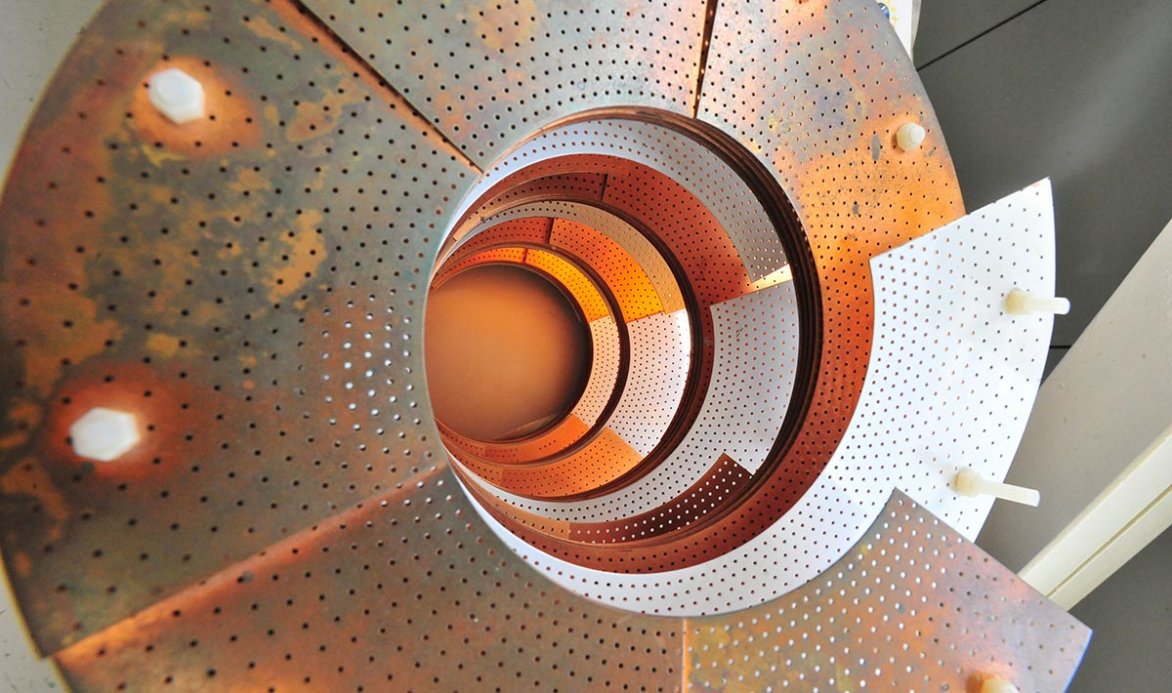 Magnets of this design (Bitter resistive magnets) remain the working horses of laboratories of strong magnetic fields.
Magnets of this design (Bitter resistive magnets) remain the working horses of laboratories of strong magnetic fields.The main consumer of the most powerful magnets throughout the 20th century was science. Thermonuclear installations, accelerators, research based on nuclear magnetic resonance, neutron physics, cooling to temperatures below 1 Kelvin, and much more require the greatest possible magnetic field strength / induction (when considering the "strength" of the field, these values can be considered synonymous).
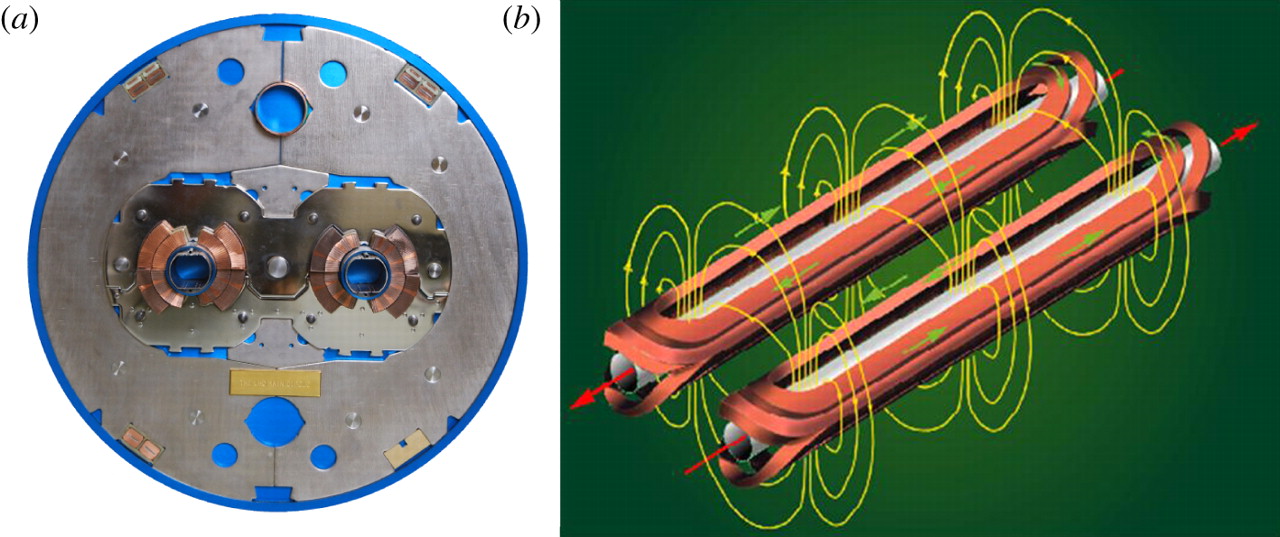 Another record magnet, which we will not discuss today, is the double dipole of the LHC accelerator - out of 1232 such rings, its main ring is dialed. A field of ~ 9 T is created by a superconducting NbTi cable cooled to 1.8 K
Another record magnet, which we will not discuss today, is the double dipole of the LHC accelerator - out of 1232 such rings, its main ring is dialed. A field of ~ 9 T is created by a superconducting NbTi cable cooled to 1.8 KBefore turning to concrete structures, it is worth remembering that the energy of a magnetic field, the strength of its effect on electric charges and diamagnets, depends on induction of B as a square. Those. a field of 10 Tesla carries 100 more energy than a field of 1 Tesla. In this case, an important characteristic is the pressure field on the current tubes, which is equal to 4 B ^ 2 atmospheres. Those. for a designer of a magnet, a field of 100 T is equivalent to trying to create a balloon at 40,000 atmospheres is an extremely difficult task. It also shows that powerful magnets with a large working volume (
as in ITER ) are even more complex than just powerful magnets.
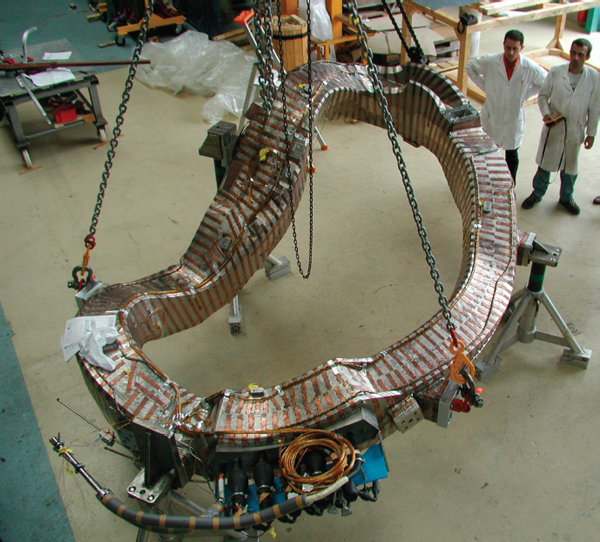 Another unusual record is the superconducting magnets of the German stellarator Wendelstein 7-X with a complex geometry.
Another unusual record is the superconducting magnets of the German stellarator Wendelstein 7-X with a complex geometry.So, we begin with the definition of some coordinates. For permanent magnets produced by the industry, field values from 0.01 to 0.5 T are typical, and neodymium magnets of 0.5 T are already perceived as “strong”. Record that can be squeezed out of permanent magnets ~ 1.5 T at the surface itself.
In electric cars (motors, generators, transformers), the field inside the iron magnetic cores is limited by the saturation of iron, with fields somewhere around 1.8-2.2 T. In the air gap of a typical induction motor, you will most likely see a field of 0.5-0.8 T, for BLDC record-breaking motors with energy-mass characteristics (4-5 kW / kg) - 1 ... 1.2 T.
 A rather original application of the power of neodymium magnets is the 19 kW electric motor (in the picture is the red cylinder), 2 such pumps use oxidant and fuel pumps on the new Rutherford rocket engine of the Rocket lab company.
A rather original application of the power of neodymium magnets is the 19 kW electric motor (in the picture is the red cylinder), 2 such pumps use oxidant and fuel pumps on the new Rutherford rocket engine of the Rocket lab company.Somewhere from 1.5 T, ordinary copper electromagnets begin to experience difficulties, primarily with heat removal. The need to intersperse copper with water cooling tubes, as well as the growing inter-turn voltage, swells the size of the magnet much faster than the field grows. The coils, which are located further from the working volume, make a relatively small contribution to the field, which means that the current is mainly spent on heating the magnet, and not on creating the field.
Copper
However, since the 1930s and almost still, record-breaking stationary fields have been achieved in practically ordinary water-cooled copper magnets. These are the so-called Bitter magnets, which are a copper plate twisted into a spiral and having a cunning system of longitudinal cooling channels. These magnets are characterized by monstrous current densities (up to 700 A / mm ^ 2), electrical powers of 1.10 and even 30 megawatts, and cooling water consumption of tens and hundreds of liters per second. The first 10 T magnet was launched in 1936, and for the next 30 years it held a record in the stationary field.
 American bitter magnets of the 60s at 25 Tesla.
American bitter magnets of the 60s at 25 Tesla.This design of magnets was then repeatedly optimized, and today the field record in such magnets has been increased to 38.5 T in the Chinese laboratory CHMFL. The power of the magnet was 28.5 MW with a cooling water consumption of 500 liters per second (by the way, it looks like the power of the magnet needs to be added about the same to the pumps that pump this water through a magnet). Current of about 36 thousand amps. In this case, a record field is achieved in a volume of only 32 mm in diameter and about 70 mm long.
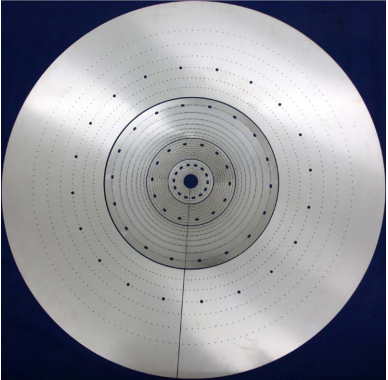
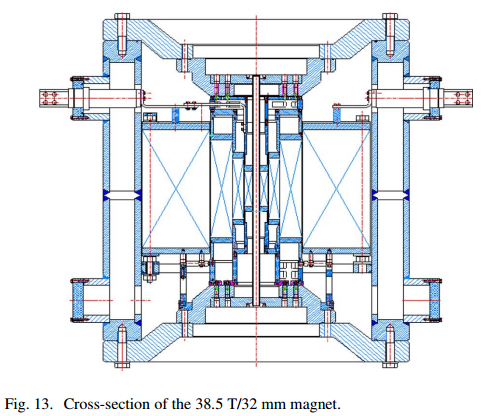
 The Chinese record resistive magnet is one run of a coil of a solenoid (made from CuAg alloy), a slit and a set of coaxial coils.
The Chinese record resistive magnet is one run of a coil of a solenoid (made from CuAg alloy), a slit and a set of coaxial coils.Resistive magnets today have approached the limits of the capabilities of materials, and the maximum available field in them grows mostly extensively - by increasing the power of the power and cooling systems, increasing the number of coils. Such magnets today are mainly used to study very diverse physical phenomena in small samples, often at low temperatures. Therefore, such magnets work in the centers of collective use, when physicists bring their samples and equipment, install it on a magnet and measure the quantities they need. For small samples it is quite convenient to use magnets with a small clearance, such as 20-30 mm.
 The top of the Bitter magnet 30 T without a cover. Here you can see the opening of the research chamber and the cooling water supply slot.
The top of the Bitter magnet 30 T without a cover. Here you can see the opening of the research chamber and the cooling water supply slot.However, there is one more application of large magnetic fields today - this is
NMR tomography , i.e. construction of tissue density maps due to the interaction of hydrogen with radio emission in a strong magnetic field. The higher the field - the greater the spatial resolution of the system. For such systems, a fairly large working volume of the magnet is needed, as well as a high field homogeneity. Research in the field of superconductivity in turn requires cryostats, which hardly fit in a diameter of 32 mm, and the field for some superconductors needs more.
 Looking ahead a little bit - a superconducting NMR tomograph with an ultra-high field (21T), a lumen of 110 mm and an example of the resulting image with a resolution of 26 μm
Looking ahead a little bit - a superconducting NMR tomograph with an ultra-high field (21T), a lumen of 110 mm and an example of the resulting image with a resolution of 26 μmTherefore, from the 80s of the 20th century, the direction of hybrid magnets appears, the idea of which is to place the Bitter magnet inside the superconducting field of which will develop. This allows you to raise the field further without increasing the already monstrous requirements for power and cooling water consumption.
HybridsInserting a Bitter magnet inside a superconducting means that the latter must have a working clearance of 400-800 mm, i.e. significantly more than the records we saw before. Magnets with large working volumes but a smaller field came to the laboratories of strong magnetic fields from tokamak developers, where in the late 70s superconducting magnets were created based on cold superconductors — tin and titanium niobate. In the mid-80s, in the French laboratory, strong magnetic fields LNCMI create a hybrid magnet from 11T superconducting and 22T bitter with a total field of 31T, and in 2000, the American National MagLab launches a hybrid installation with a field of 45T, which is still the highest among all magnets with constant field.
 The body of the entire magnet (left) and cryostat (right)
The body of the entire magnet (left) and cryostat (right)
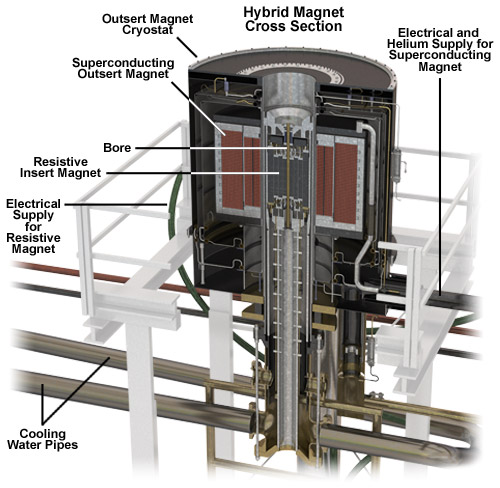
Cross section of a hybrid magnet in a cryostat. By the way, the construction of an external superconducting magnet designed for this installation was then used in three more record magnets.The 45th Tesla Hybrid uses three external superconducting magnets and four internal resistive Bitter-Florida types. The resistive part consumes 29 megawatts at a current of 74 kA and creates a field of 31 T. The superconducting part of the magnet creates a field of 14 T and consists of external windings of NbTi and internal of Nb3Sn, operates at a current of 8 kA at a temperature of 4.2 K. Clearance superconducting magnet cryostat - 500 mm.
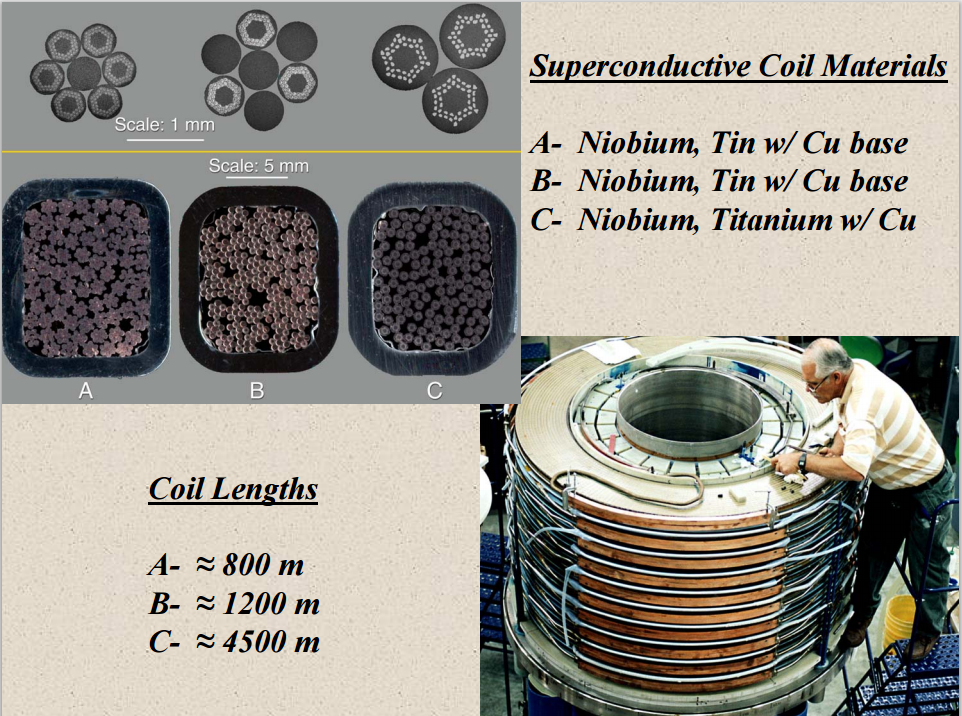 45T superconducting external fridge magnet
45T superconducting external fridge magnet
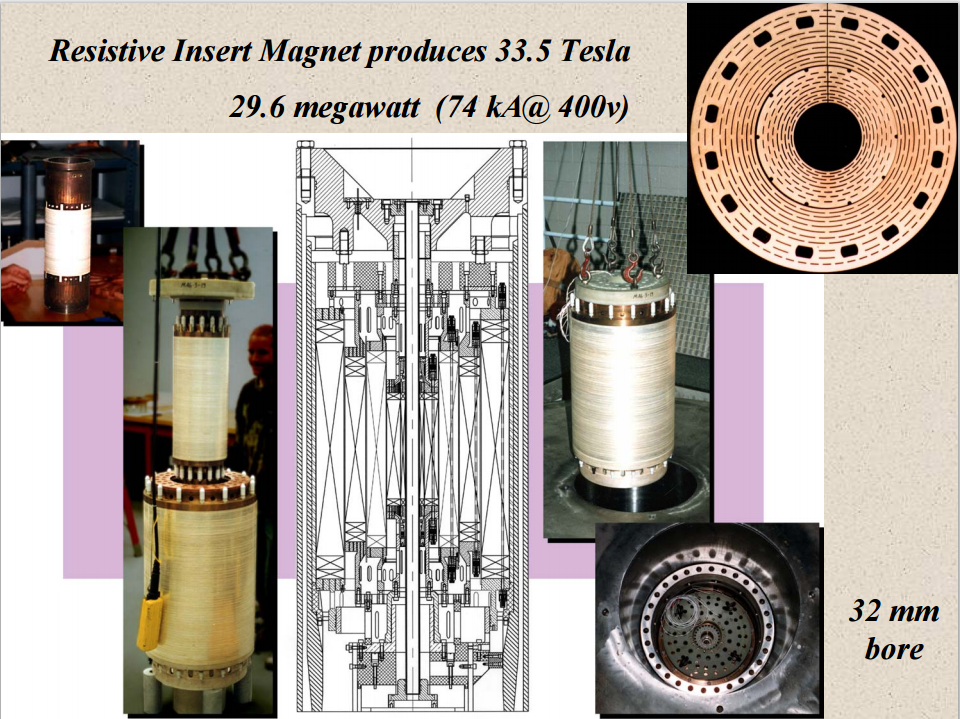
And the internal bitter magnet. So 2.5 meters of the body turns into a 32 mm working chamber.For comparison, let me remind you that the ITER toroidal magnet has a current of 68 kA, a field of 12.8 T with a clearance of 9000x7000 mm, i.e. One can imagine how far ITER has moved the technology of low-temperature superconducting magnets.
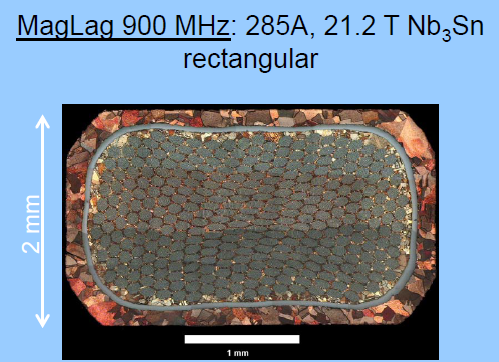 By the way, in laboratory magnets use a conductor with a much smaller current, winding more turns - this simplifies the power system and the conductor itself. The flip side of this is a large electrical voltage in the system when the superconductor suddenly goes into a normal state.
By the way, in laboratory magnets use a conductor with a much smaller current, winding more turns - this simplifies the power system and the conductor itself. The flip side of this is a large electrical voltage in the system when the superconductor suddenly goes into a normal state.In addition to ITER, these technologies have moved forward with the advent of industrial high-temperature superconductors. If low-temperature joint ventures in principle do not allow the creation of fields above 22 T, i.e. they can only be part of a record magnet, for HTSC this limit extends to at least 45 T.
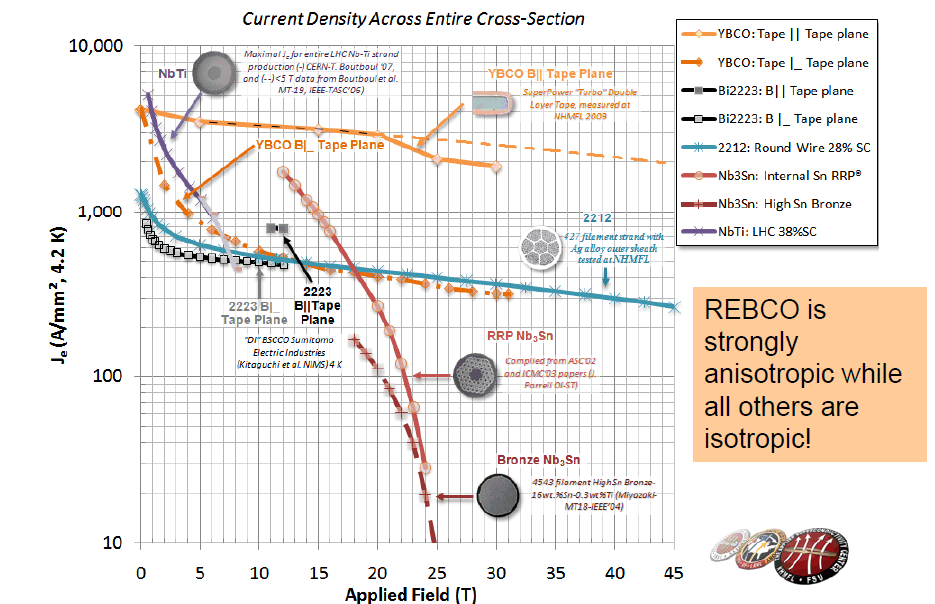 The dependence of the critical current density on the field of different superconductors. By the way, have you ever wondered what kind of equipment is used to build these diagrams and why do they run into 45T?
The dependence of the critical current density on the field of different superconductors. By the way, have you ever wondered what kind of equipment is used to build these diagrams and why do they run into 45T?Today, the new direction of creating record magnets is completely superconducting and now all the leading laboratories of the world (China, Netherlands, France, USA) are designing SP-magnets for 30+ T. Here, too, Florida MagLab, where the assembly of a fully superconducting magnet has begun, is still ahead of everyone. T. Here, 15 T will be created by external magnets from NbTi and Nb3Sn, and another 17 - by a two-layer HTS magnet from YBCO tapes. “High-temperature” superconductors are used here as having much higher critical fields at liquid-helium temperature than “low-temperature” ones.
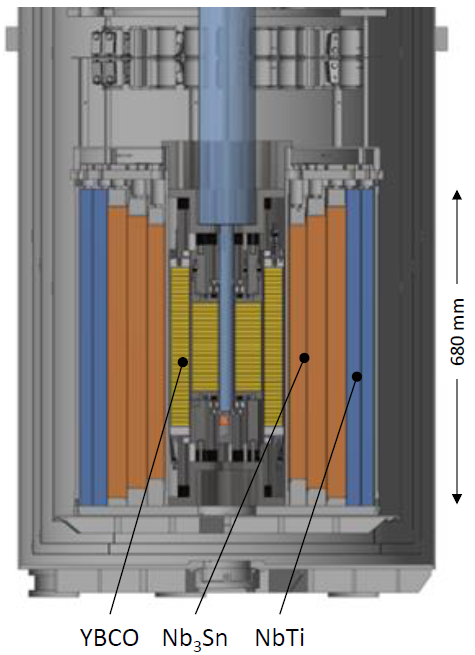 32T fully superconducting magnet design
32T fully superconducting magnet designThe technology of this magnet required almost 10 years of development, the main problems lay in the field of very high ponderomotive forces from the powerful magnetic field on the coils with current. The mechanical stress in YBCO coils reaches 700 MPa - here, by the way, it helps that the HTS ribbon basically consists of a nickel alloy with high strength characteristics - copper does not withstand such stresses.
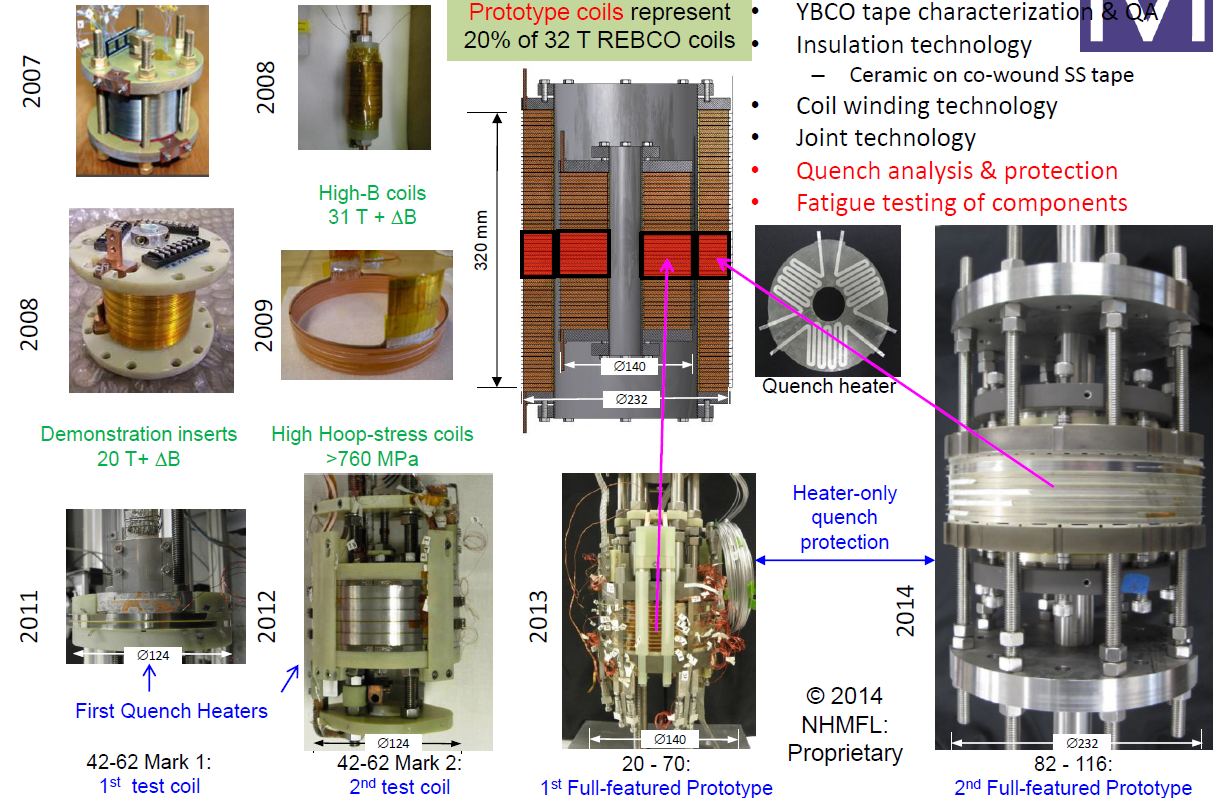 R & D of high field HTS magnet.
R & D of high field HTS magnet.The second class of problems is associated with the accidental loss of the superconducting state, and the current output from the coils. In particular, to avoid burnout due to the slow propagation of the normal zone, heaters are embedded in the coils, which, when a transition is detected, heat the entire coil so that the field energy is released more evenly.
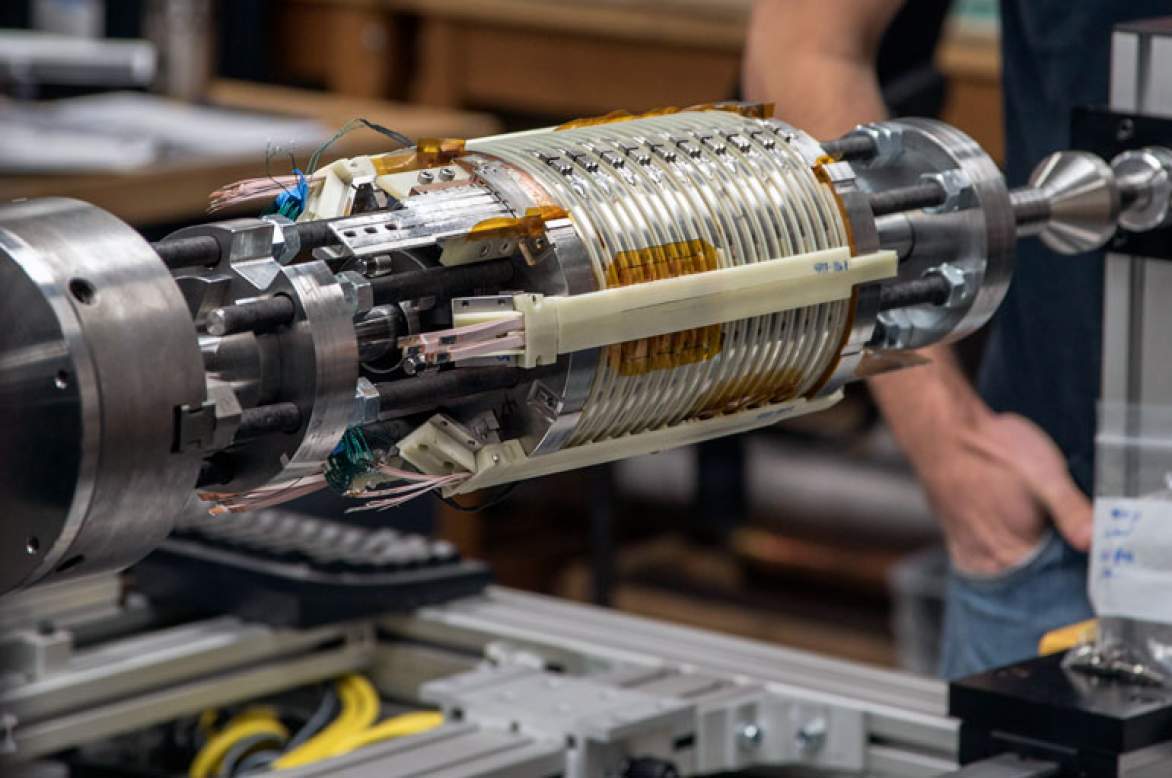 Just recently, an internal working coil was made from the HTS tape, and we can soon expect the launch and assembly of the magnet.
Just recently, an internal working coil was made from the HTS tape, and we can soon expect the launch and assembly of the magnet.This magnet will have a “cold” working volume, and is well suited for studying condensed matter states and quantum effects in solids, while in terms of operating costs it is a completely different class of devices, in particular a cryostat, a cryo-supply system and an external SP-magnet from NTSC serial products manufactured by Oxford Instruments.
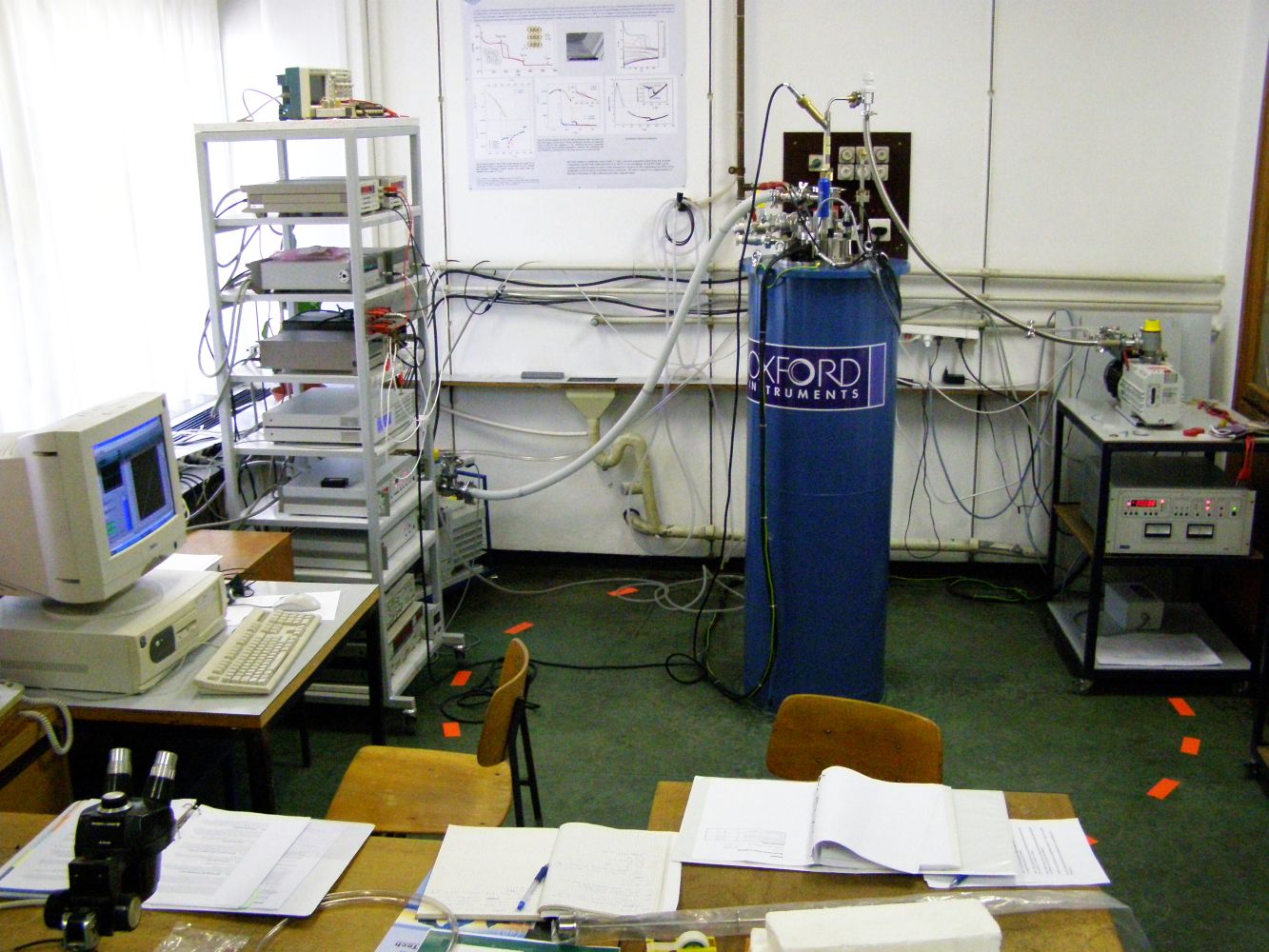
In general, oxford instruments is the largest supplier of superconducting magnets, mainly for all scientific and laboratory applications for 3-15T fields. In the ITER project, for example, this company supplies 6T magnets for gyrotrons.
In general, before moving on to the next record holders, I would like to say about several applications of such magnets beyond just providing a stand with high magnetic fields.
One of the main applied consumers of serial high-field magnets is NMR spectrometers, a working tool for chemists. Bruker, in particular, serially produces spectrometers with a field of up to 23.5T (such plants, by the way, have quite big problems with screening such a field from surrounding people and objects).
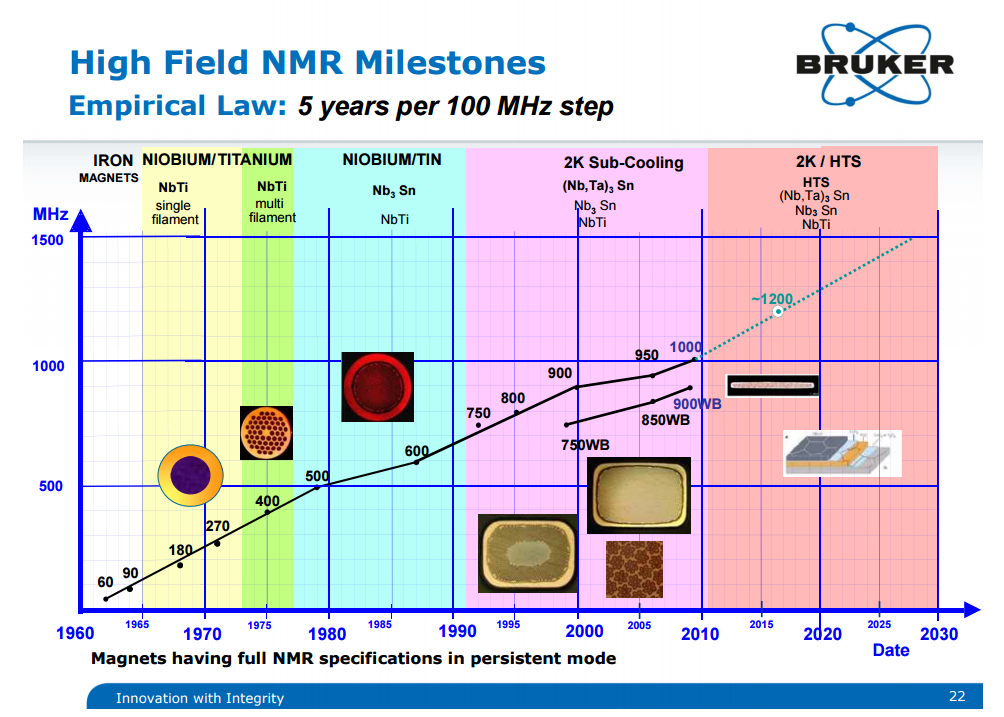 The historical increase in the frequency of NMR spectrometers, which allows to improve the quality of the NMR spectra.
The historical increase in the frequency of NMR spectrometers, which allows to improve the quality of the NMR spectra.The second serial consumer is high resolution NMR tomographs, which are used in biological and neurobiological studies. Here, the fields reach 21T. Finally, centers with neutron sources are a little less applied to consumers; one of the methods for studying magnetic quantum phenomena is the study of neutron scattering on matter in a strong magnetic field, as well as refrigerators for submicrokelvin temperatures requiring fields from 8 to 20 T.
Video from the 26T magnet assembly with a large clearance for the study of the scattering of polarized neutrons on matter in Helmholtz-Zentrum BerlinImpulse magnetsThe main engineering problems of creating high-field magnets — heat sink and strength — are greatly alleviated if we move from a constant magnetic field to a pulsed one. In turn, pulse systems are divided into reusable and disposable :)
Interestingly, the pioneer in the field of pulsed magnets was Peter Kapitsa, who was engaged in similar installations in the 20s in the Cavendish laboratory in England. Closing the output of a large rotating generator on the solenoid, he received up to 50 T in a few milliseconds. Such an approach made it possible to measure many of the quantities associated with large magnetic fields even in the 20s, and with modern recording technology in general such a field can be called almost quasistationary.
 Kapitsa and his machine to create pulsed magnetic fields.
Kapitsa and his machine to create pulsed magnetic fields.Improving this approach, in the 60s, developers switched from rotating electromechanical energy sources to capacitors and voltage pulse generators, which allow to create a current density in many kiloampers per mm ^ 2 in a copper coil.
Combined with power reinforcement in the form of a steel matrix and liquid nitrogen cooling (to reduce resistance, which reduces the voltage required, which makes insulation in such a magnet easier), in 2012, pulsed copper magnets reached 101.2 T within 1 millisecond - this value today is a record (and belongs to the collaboration of the American nuclear weapons laboratory LANL and the Florida MagLab).
Video about achieving a record field value of 101.2 T. However, there is little that can be seen here, and in general there is a feeling that the design of the magnet is classified, only common values are knownThis value is also achieved with the help of several nested coils, the outer of which give a long pulse (about 2 seconds) with an amplitude of up to 45 T, and the internal - a short pulse of 65 T. Such a scheme allows to withstand the stresses in the conductor beyond the yield strength of the materials.
Interestingly, the power of such a magnet reaches several gigawatts.
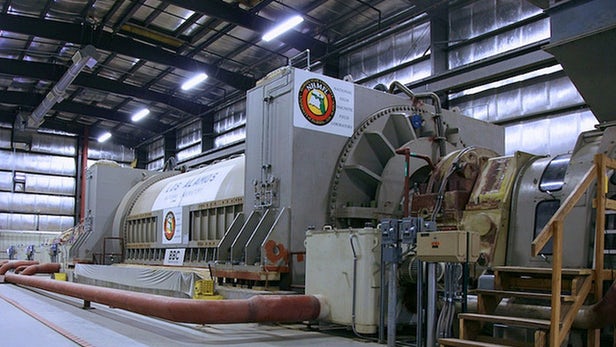 The generator, which is short-circuited to the external windings of the magnet to obtain a record pulse fields.
The generator, which is short-circuited to the external windings of the magnet to obtain a record pulse fields.Unfortunately, no paths are yet visible for a noticeable increase in the field value in a reusable installation. However, if the destruction of the installation is not terrible for us, then 101 T is far from the limit.
The simplest option here is a piece of copper rolled into a coil, onto which high-voltage capacitors are connected. Such a scheme makes it possible to obtain 300 and 400 tesla, though for a very short time (on the order of a microsecond) in a volume of several cubic millimeters, which for an experimenter who studies the topology of Fermi surfaces in solids, for example, is quite complex limitations.
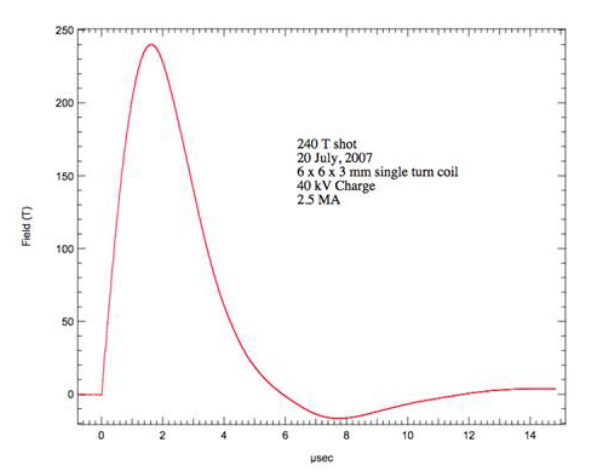 Impulse field on a disposable magnet.
Impulse field on a disposable magnet.A rather elegant way out of these limitations was found as early as the 50s by the invention of explosive magnetic generators. Here the seed magnetic field of 10-20 T is compressed to 2800 (!) T. This is done with the help of a metal cylindrical liner, which with the help of a cylindrical blast wave from the explosive charge collapses to its axis. In this case, the longitudinal magnetic field increases approximately 100–200 times. Compared with the previous scheme, a slightly longer pulse time of the magnetic field can be obtained in an explosive magnetic generator, and a slightly larger volume for the sample, although at the price of a much more complicated experiment.
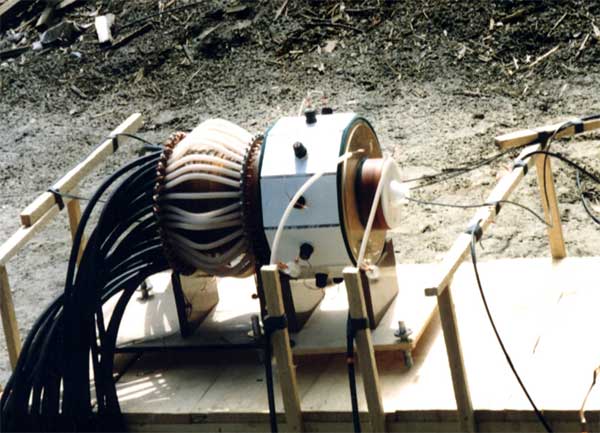
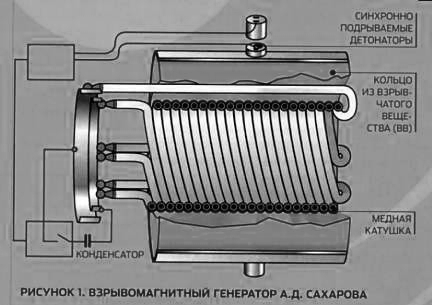 Explosive magnetic generator and its schematic diagram.
Explosive magnetic generator and its schematic diagram.Back in the 50s, using the VMG, various characteristics of materials in an extreme magnetic field — conductivity, polarization rotation (Faraday effect), compression of the magnetic field of an atomic nucleus, etc. — were measured. Another interesting result is the possibility of acceleration of metallic objects by such magnetic fields up to speeds of the order of 100 km / s.
The field limitations of explosive magnetic generators, in turn, are again quite fundamental and are related to the pressure of the magnetic field, which reaches tens of megabar and stops the metal liner. 3000 Tesla here apparently is the asymptotic limit.
In turn, greater pressure values (gigabars) are achieved in laser implosion installations, and theoretically such installations are capable of creating magnetic fields of tens of thousands and even 100 thousand tesla, albeit in nanoseconds and in micron volumes. The focused laser pulse from a petawatt laser itself has an alternating magnetic field with an amplitude even higher — a million tesla and higher. Of course, the conditions in which such a field arises (a dense plasma with a temperature of hundreds of eV - tens of keV) are far from the interests of applied science, but very interesting to fundamental science.
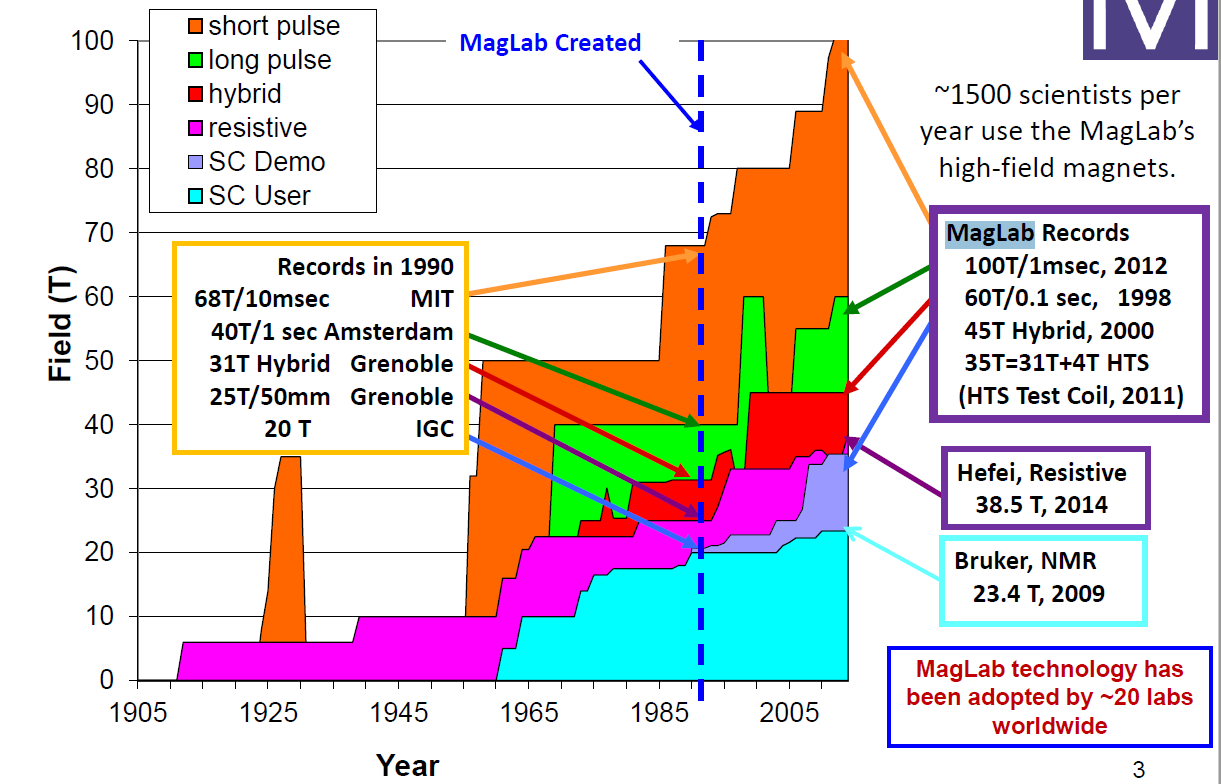 History of magnetic field records for different types of installations (reusable :))
History of magnetic field records for different types of installations (reusable :))Concluding the review of magnetic records, it is worth remembering about magnetars - young neutron stars with high magnetic fields. High here is up to 100 billion Tesla. A magnetic field of this order, for example, has an energy density of 10 ^ 25 J per cubic meter, the equivalent of mc ^ 2 for a substance 10,000 times denser than lead.
Observations on magnetars (and ordinary neutron stars, whose fields are thousands of times smaller) make it possible to better understand the behavior of matter and space under such conditions, complementing laboratory studies with record magnets.